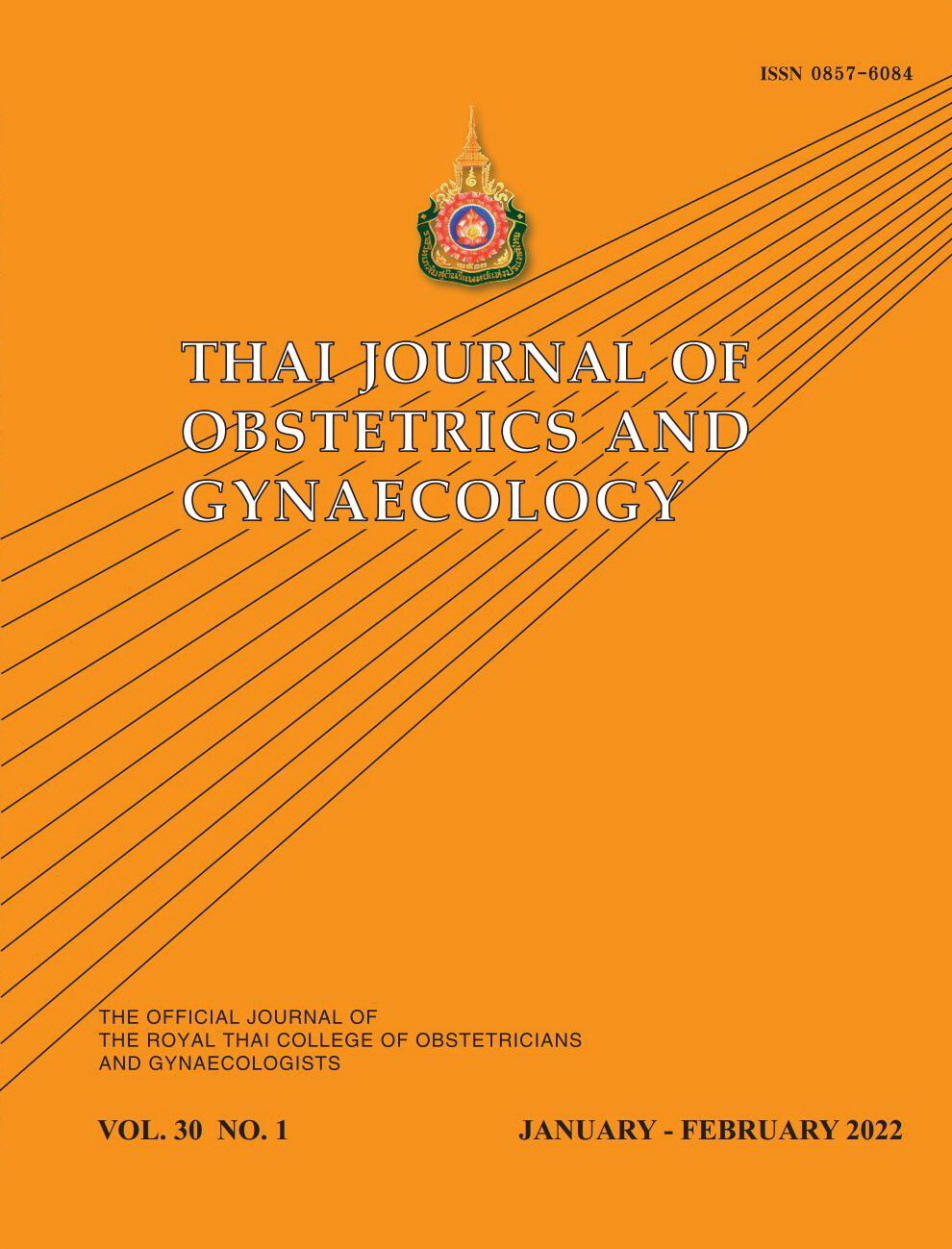Lidocaine Infiltration in Mesosalpinx for Reducing Operative Time in Postpartum Tubal Sterilization: A randomized, controlled trial
Main Article Content
Abstract
Objectives: To evaluate the efficacy and dosage of lidocaine infiltration in mesosalpinx for reducing operative time in postpartum tubal sterilization.
Materials and Methods: A randomized, double-blinded, placebo-controlled trial was conducted in 105 women at Khon Kaen Hospital between April and July 2020. The participants were randomly assigned into three groups 4 ml of 2% lidocaine, 1% lidocaine, and normal saline solution (NSS) infiltrated in the mesosalpinx. Systemic sedative drugs were administered before the procedure in all groups. Operative time from skin incision to closure was recorded. Intra-operative, immediately and 1 hour post-operative pain score were evaluated.
Results: Age and body mass index were not statistically different between 2% lidocaine, 1% lidocaine, NSS groups (29.00 ± 4.54, 30.37 ± 5.92, 31.03 ± 5.08 yrs. and 25.08 ± 3.14, 25.88 ± 2.82, 26.08 ± 2.60 kg/m2, respectively). Other baseline characteristics including postpartum duration before sterilization, parity, gestational age, and level of surgeon experience were similar across groups. Mean operative time for 2% lidocaine, 1% lidocaine, and NSS group was 17.9 ± 6.19, 21.6 ± 9.72, and 23.1 ± 12.04 min. The operative time of 2% lidocaine was significantly shorter than NSS (p = 0.027), and pain scores in 2% lidocaine were significantly lower than for NSS for all periods. The operative time of 1% lidocaine was not significantly different compared to NSS whereas 1% lidocaine had a significantly lower pain score only immediately and 1 hour post-operation. There were no serious adverse events found.
Conclusion: Two percent lidocaine infiltration in the mesosalpinx significantly shortened operative time and could reduce pain throughout postpartum tubal sterilization.
Article Details

This work is licensed under a Creative Commons Attribution-NonCommercial-NoDerivatives 4.0 International License.
References
Arab M, Manochehrian N, Mehrangiz Z. The effect of bupivacaine infiltration on postoperative tubal-ligation pain. Internet J Pain Symptom Control Palliative Care 2003;3:31-6.
American College of Obstetricians and Gynecologists. ACOG Practice bulletin no. 133: Benefits and risks of sterilization. Obstet Gynecol 2013;121:392-404.
Wittels B, Faure EAM, Chavez R, Moawad A, Ismail M, Hibbard J, et al. Effective analgesia after bilateral tubal ligation. Anesth Analg 1998;87:619-23.
Shivanna P, Raghuram S. Effect of pre-incisional and mesosalpinx infiltration of local anaesthesia for post-operative analgesia in bilateral abdominal tubectomies-a randomized placebo-controlled study. J Evid Based Med Healthc 2017;4:2437-42.
Sokol E. Clinical anatomy of the uterus, fallopian tubes, & ovaries. The Global Library of Women’s Medicine [internet]. 2009 [cited 2019 Jun 26]. Available from: https://www.glowm.com/section_view/item/1
Jacobstein R, ed. Minilaparotomy for female sterilization. 1st ed. New York: Automated graphic systems 2003: 25-37.
World Health Organization. WHO model prescribing information: drugs used in anaesthesia: local anaesthetics. Geneva: World Health Organization 1989.
Songserm V, Werawatakul Y, Sothornwit J, Prasit M, Thongpha S. Lidocaine injection in mesosalpinx for pain relief during post-partum tubal sterilization in Srinagarind Hospital: A randomized controlled trial. Thai J Obstet Gynaecol 2017;25:11-7.
American Society of Anesthesiologists. ASA Physical Status Classification System 1995 [cited 2019 Jun 26].
Wysham NG, Miriovsky BJ, Currow DC, Herndon JE, Samsa GP, Wilcock A, et al. Practical dyspnea assessment: relationship between the 0-10 numerical rating scale and the four-level categorical verbal descriptor scale of dyspnea intensity. J Pain Symptom Manage 2015;50:480-7.


